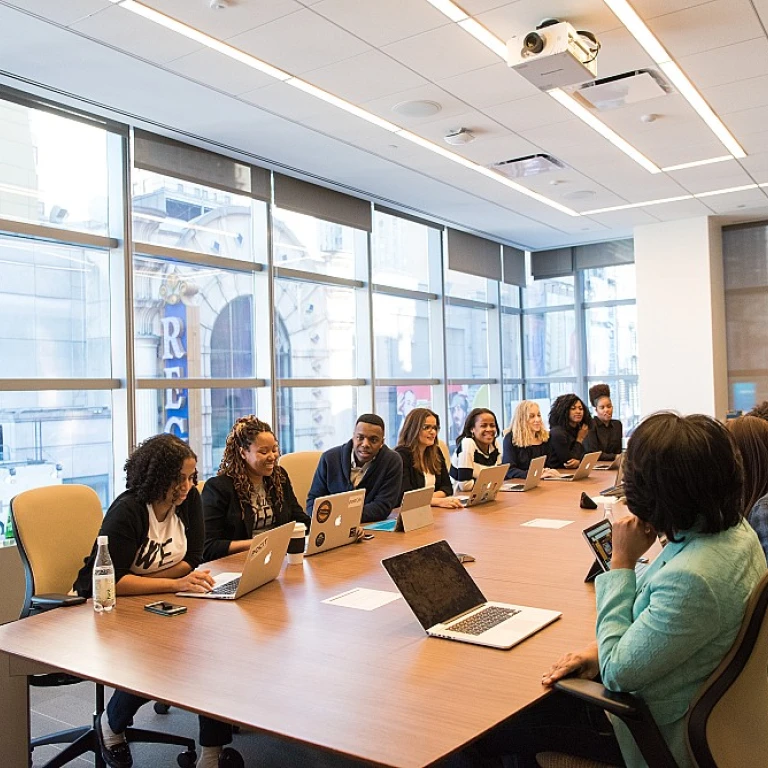Understanding the Role of Recognition in Innovation
The Importance of Acknowledgement for Innovation
Employee recognition stands as a cornerstone in fostering innovation within any organization. It's widely acknowledged that when employees feel valued and appreciated, they are more likely to contribute creatively and take ownership of their projects. This goes hand in hand with enhancing employee engagement—ultimately benefiting the company’s innovation capabilities. A culture of recognition not only boosts morale but also creates a competitive edge by creating an environment where innovative ideas are encouraged and cultivated. Employees who regularly receive positive acknowledgment are inherently motivated to think outside the box and push boundaries. This leads to a continual cycle of improvement and evolution within the organization. By emphasizing employee recognition, companies can effectively integrate innovation into the workplace mindset. Recognition should be perceived not just as a pat on the back, but as a strategic tool to align employees with the organization's goals. Moreover, recognition paves the way for an inclusive culture where every contribution is celebrated, leading to increased collaboration and diverse brainstorming sessions. Fostering this sense of inclusion and appreciation can break down silos and enhance communication across departments. To delve deeper into the ways recognition can drive an innovative culture, this source offers insights on how strategic recognition can reinforce an organization's innovative framework.Designing Tailored Reward Systems
Crafting Personalized Reward Structures
In the evolving landscape of human resources, the design of reward systems plays a crucial role in fostering employee engagement and driving innovation. Traditional one-size-fits-all approaches to rewards are increasingly being replaced by more personalized systems that cater to the diverse needs and preferences of employees.
To effectively design tailored reward systems, organizations must first understand the unique motivations and values of their workforce. This involves gathering data through surveys, feedback sessions, and performance metrics to identify what truly resonates with employees. Acknowledging the diversity within teams is essential, as it allows for the creation of reward structures that are inclusive and equitable.
Incorporating Flexibility and Choice
Flexibility is a key component in modern reward systems. Offering employees a range of options allows them to choose rewards that align with their personal and professional goals. For example, some employees might value additional time off, while others might prefer professional development opportunities or financial bonuses.
Implementing a points-based system is one way to provide flexibility. Employees can accumulate points for various achievements and redeem them for rewards of their choice. This approach not only empowers employees but also encourages a sense of ownership over their achievements.
Aligning Rewards with Organizational Goals
For reward systems to be truly effective, they must align with the broader objectives of the organization. By linking rewards to specific business goals, companies can ensure that recognition efforts contribute to the overall success of the organization. This alignment also helps in reinforcing desired behaviors and outcomes among employees.
For instance, if innovation is a key priority, rewards can be structured to recognize creative problem-solving and the development of new ideas. This not only motivates employees to contribute to the company’s innovation agenda but also helps in cultivating a culture of continuous improvement.
As organizations continue to explore innovative recognition strategies, it is essential to keep in mind the challenges that may arise during implementation. By anticipating potential obstacles, companies can better prepare to address them and ensure the success of their recognition programs.
Leveraging Technology for Effective Recognition
Utilizing Digital Tools for Seamless Employee Recognition
In today's digital age, leveraging technology for recognition can streamline the process and make it more efficient. Effective use of technology in employee recognition helps organizations reach their workforce, fostering {{ human resources innovation }}. Technology acts as a conduit that fosters timely acknowledgment, which significantly impacts employee morale and productivity.
There are several ways organizations can incorporate technology into their recognition programs:
- Automated Recognition Platforms: These platforms can simplify the management of recognition activities. Employers can instantly recognize achievements through automated tools that are integrated within existing systems, ensuring no effort goes unnoticed.
- Mobile Applications: Mobile apps offer flexibility and accessibility, enabling employees to receive recognition anytime, anywhere, supporting the growing trend of remote work. This is particularly beneficial for virtual teams, aligning with the evolving role of CHROs in managing diverse work environments.
- Gamification: By introducing elements of gamification, companies can create a fun and engaging atmosphere. Leaderboards and point systems can inspire friendly competition among employees, expanding the concept of {{ innovative employee rewards }}.
- Data Analysis and Feedback: Leveraging analytics can offer insights into employee engagement levels, providing data-driven feedback to refine recognition strategies.
The integration of these digital tools within a recognition program not only enhances the immediacy of acknowledgment but also aligns with future trends in {{ employee recognition }}. As technology continues to evolve, these tools will play a crucial role in tailoring recognition in a manner that resonates with each employee, supporting a culture of appreciation and innovation.
Case Studies: Successful Implementation of Innovative Recognition
Real-World Examples of Innovative Recognition Programs
Innovative recognition and reward systems have been successfully implemented by various organizations, leading to enhanced employee engagement and productivity. These real-world examples provide valuable insights into how businesses can effectively recognize and reward their employees.
Tech Giant's Peer-to-Peer Recognition
A leading technology company implemented a peer-to-peer recognition platform, allowing employees to recognize each other's contributions in real-time. This system not only empowered employees to acknowledge their peers but also fostered a culture of appreciation and collaboration. The platform was integrated with the company's existing communication tools, making it easy for employees to give and receive recognition. This approach resulted in increased employee satisfaction and a stronger sense of community within the organization.
Retail Chain's Personalized Rewards
A major retail chain introduced a personalized rewards system that aligned with individual employee preferences. By utilizing data analytics, the company was able to tailor rewards to match employees' interests and achievements. This personalized approach ensured that the rewards were meaningful and motivating, leading to improved performance and retention rates. The success of this program highlights the importance of designing tailored reward systems that resonate with employees on a personal level.
Financial Firm's Gamified Recognition
A financial services firm adopted a gamified recognition platform to engage its workforce. Employees earned points for achieving specific milestones, which could be redeemed for various rewards. The gamification element added an element of fun and competition, encouraging employees to strive for excellence. This innovative approach not only boosted morale but also drove productivity and innovation within the company.
Lessons Learned from Successful Implementations
- Integration with Existing Tools: Seamless integration with current communication and workflow tools can enhance the effectiveness of recognition programs.
- Personalization: Tailoring rewards to individual preferences can significantly increase their impact and relevance.
- Engagement through Gamification: Introducing gamified elements can make recognition programs more engaging and enjoyable for employees.
These case studies demonstrate that innovative recognition and reward systems can be a powerful tool for enhancing employee engagement. By understanding the role of recognition in fostering an innovative culture, organizations can design effective programs that meet the unique needs of their workforce.
Challenges in Implementing Recognition Programs
Overcoming Hurdles in Recognition and Reward Programs
Incorporating recognition in the workplace holds immense potential for enhancing employee engagement and innovation. Yet, companies often face several challenges when implementing these programs. Here are some common hurdles and strategies to address them:- Lack of Clear Objectives: Many organizations struggle because they do not set clear goals. It's crucial to align recognition systems with overall business objectives and a culture of innovation. Clear communication helps employees understand the purpose of the rewards and engage with them effectively.
- Consistency and Fairness: Recognition programs can sometimes be perceived as biased if not universal and consistent. Designing tailored reward systems that are adaptable to different departments and job roles can ensure fairness. Equitable recognition ensures employees feel valued across all levels.
- Technology Integration Problems: Another challenge is effectively leveraging technology to streamline recognition efforts. Implementing platforms that are user-friendly and accessible can mitigate this. Organizations can learn from industry case studies about successful tech integration to enhance their efforts.
- Lack of Engagement: Employees may not participate in or value recognition systems, diminishing their effectiveness. Regular feedback and involvement of employees in designing these programs can increase participation rates.
- Measuring Impact: It can be difficult to quantify the impact of recognition programs on innovation and productivity. Establishing metrics and collecting feedback helps in assessing the program’s success and guides continuous improvement.
Future Trends in Employee Recognition and Rewards
Emerging Trends on the Horizon
The landscape of employee recognition and rewards is evolving rapidly, and staying abreast of these changes is crucial for organizations aiming to enhance employee engagement. One of the most significant trends is the increasing personalization of the recognition process. Employers are learning to tailor their approaches based on individual preferences, as highlighted in the tailored reward systems section. This personalized touch not only makes employees feel valued but also aligns with their personal goals and motivations.
The Role of AI and Data Analytics
Technology, particularly AI and data analytics, plays an instrumental role in shaping the future of recognition programs. Leveraging technology, as previously discussed, allows companies to gather data and gain insights into what types of recognition are most effective. These insights empower HR teams to make data-driven decisions, thereby enhancing the efficacy of their recognition strategies.
Holistic Well-Being as a Focus
As part of comprehensive employee engagement strategies, there is a growing emphasis on holistic employee well-being. Future recognition programs may increasingly incorporate elements aimed at supporting mental health and work-life balance. This shift acknowledges the various facets of well-being that contribute to overall productivity and satisfaction.
The Shift Towards a Continuous Feedback Loop
Organizations are transitioning from traditional annual performance reviews to continuous feedback systems. Such systems promote ongoing dialogue, enabling real-time recognition and correction, and fostering a culture of continuous improvement. By integrating feedback mechanisms into recognition programs, companies create an environment where employees feel consistently supported and motivated.
Adapting to a Diverse Workforce
Finally, addressing the diversity of the modern workforce is paramount. Recognition programs are increasingly becoming inclusive, taking into account cultural variations and different workforce compositions. This trend is particularly important as workplaces become more globalized, and a one-size-fits-all approach is no longer viable.
While the future of employee recognition and rewards presents its set of challenges, understanding and anticipating these trends ensures that organizations remain competitive and responsive to their employees' needs in an ever-changing environment. As companies look to innovate and enhance their approaches, staying informed about these trends will be critical in crafting effective and impactful recognition strategies.



